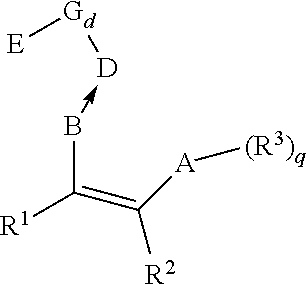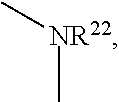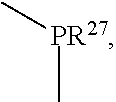Supported nonmetallocene catalyst and preparation thereof
a nonmetallocene catalyst and catalyst technology, applied in the field of supported nonmetallocene catalysts, can solve the problems of short service life, high consumption of methyl aluminoxane, low or high molecular weight, etc., and achieve the effect of increasing load, simple and feasible, and easy to adjust the load of nonmetallocene ligands
- Summary
- Abstract
- Description
- Claims
- Application Information
AI Technical Summary
Benefits of technology
Problems solved by technology
Method used
Image
Examples
example
[0240]The present invention is further illustrated by using the following examples, but the present invention is not confined to same.
[0241]The bulk density of the polymer is measured according to the Chinese Standard GB 1636-79 (unit: g / cm3).
[0242]The content of the Group IVB metal in the supported nonmetallocene catalyst is determined by the ICP-AES method, while the content of the nonmetallocene ligand in the supported nonmetallocene catalyst is determined by the element analysis method.
[0243]The polymerization activity of the catalyst is calculated as follows.
[0244]At the end of the polymerization, the polymer product in the reactor is filtered, dried and weighed for its weight (by mass). Then, the polymerization activity of the catalyst is expressed by a value obtained by dividing the weight of the polymer product by the amount (by mass) of the catalyst used in the polymerization (unit: kg polymer per 1 g Cat).
example i-1
[0245]A silica gel (ES757, from the Ineos company) was used as the porous carrier, which had been thermally activated at 600° C. under a N2 atmosphere for 4 hours before use.
[0246]5 g of the thermally activated silica gel was weighted, and 50 nil of hexane as the solvent in this step was added thereto. Then, TiCl4 (as the chemical treating agent) was dropwise added thereto over a period of 30 minutes under stirring, and was reacted for 4 hours at 60° C. under stirring. The resultant was then filtered, washed by hexane for 3 times (25 ml per time), and dried at 60° C. for 2 hours, so as to obtain a modified porous carrier.
[0247]In this step, the ratio of TiCl4 to the porous carrier was 9.4 mmol to 1 g.
[0248]A nonmetallocene ligand of the structure
[0249]
was dissolved in hexane (as the solvent for dissolving the nonmetallocene ligand), then the modified porous carrier was added thereto, and the reaction continued under stirring for 4 hours. After filtrated, washed by hexane for 2 times...
example i-1-1
[0252]Substantially the same as the Example I-1, except for the following changes:
[0253]Al2O3 was used as the porous carrier, and the thermal activation was conducted at 800° C. under a N2 gas atmosphere for 12 hours.
[0254]The ratio of titanium tetrachloride to the porous carrier was 14 mmol to 1 g, and the solvent in this step was changed to decane.
[0255]The nonmetallocene ligand was changed to
[0256]
[0257]the concentration by mass of the nonmetallocene ligand was 0.12 g / ml;
[0258]the ratio of the nonmetallocene ligand to the porous carrier was 0.386 mmol to 1 g; and
[0259]the solvent for dissolving the nonmetallocene ligand was changed to decane.
PUM
| Property | Measurement | Unit |
|---|---|---|
| temperature | aaaaa | aaaaa |
| laser particle size analyzer | aaaaa | aaaaa |
| temperature | aaaaa | aaaaa |
Abstract
Description
Claims
Application Information
 Login to View More
Login to View More - R&D
- Intellectual Property
- Life Sciences
- Materials
- Tech Scout
- Unparalleled Data Quality
- Higher Quality Content
- 60% Fewer Hallucinations
Browse by: Latest US Patents, China's latest patents, Technical Efficacy Thesaurus, Application Domain, Technology Topic, Popular Technical Reports.
© 2025 PatSnap. All rights reserved.Legal|Privacy policy|Modern Slavery Act Transparency Statement|Sitemap|About US| Contact US: help@patsnap.com



